Why this resume works
- Quantifies accomplishments: By increasing team performance by 20% annually, the applicant clearly showcases their ability to drive impact with measurable achievements.
- Highlights industry-specific skills: Managing swim meet logistics and developing programs for over 30 athletes highlights industry-specific skills important for roles in aquatic centers and competitive sports settings.
- Illustrates problem-solving ability: The innovative development of training programs, boosting membership by 15%, illustrates effective problem-solving skills through strategic program implementation.
More Swim Coach Resume Examples
See our swim coach resume examples to learn how to present your coaching skills, aquatic expertise, and ability to motivate swimmers. These sports resume samples will help you craft a resume that highlights your coaching achievements effectively.
Entry-Level Swim Coach
Why this resume works
- Centers on academic background: Emphasizing a master’s degree in exercise science in the education section reflects a strong academic foundation, combining theoretical knowledge with hands-on experience in sports and athlete development.
- Effective use of keywords: Strategically integrating role-specific keywords like “team leadership” and “performance metrics” ensures alignment with industry expectations while optimizing the resume for applicant tracking systems (ATS).
- Shows digital literacy: Managing swim events monthly and developing personalized training programs indicate an understanding of modern computer skills essential for planning, data tracking, and performance analysis.
Mid-Level Swim Coach
Why this resume works
- Points to measurable outcomes: By detailing achievements like a 45% increase in team size and 10 state-level medals, the applicant clearly showcases their effectiveness and significant impact in coaching roles.
- Demonstrates language abilities: Language skills in Spanish, French, and Italian improves cross-cultural communication, supporting diverse athlete engagement.
- Clear contact information: A well-crafted resume header ensures the applicant is easily reachable, which is key for securing callbacks from potential employers.
Experienced Swim Coach
Why this resume works
- Focuses on work history: Through a chronological resume, the applicant showcases extensive experience in swim coaching, illustrating progression and accomplishments like boosting team enrollment by 25%.
- Emphasizes leadership skills: The applicant’s leadership shines through initiatives like training athletes for regional championships, reflecting strong leadership skills by improving team performance annually and managing large groups effectively.
- Lists relevant certifications: Relevant certifications such as Certified Swim Coach and Water Safety Instructor underpin the applicant’s expertise and commitment to maintaining high standards in aquatic sports.
Swim Coach Resume Template (Text Version)
Larry Garcia
Westbrook, ME 04093
(555)555-5555
Larry.Garcia@example.com
Professional Summary
Experienced Swim Coach boosting performance by 20% annually, specializing in team management and training development for competitive athletes.
Work History
Swim Coach
Pacific Waves Aquatic Center – Westbrook, ME
January 2022 – August 2025
- Increased team performance by 20% annually
- Developed training programs for 30+ athletes
- Managed swim meet logistics and schedules
Aquatic Director
Seaside Swim Club – Portland, ME
January 2017 – December 2021
- Oversaw safety standards for 50+ staff
- Boosted membership by 15% annually
- Implemented effective swim programs
Assistant Swim Coach
North Shore Aquatics – Portland, ME
January 2016 – December 2016
- Aided in training junior swim team
- Improved swim techniques for 20+ athletes
- Organized competitive swim events
Skills
- Team Management
- Training Development
- Performance Analysis
- Safety Protocols
- Event Coordination
- Athlete Mentorship
- Technique Improvement
- Aquatic Programming
Education
Master of Science Sports Management
University of Southern California Los Angeles, CA
May 2015
Bachelor of Science Kinesiology
California State University Long Beach, CA
May 2013
Certifications
- Certified Swim Coach – American Swimming Coaches Association
- CPR and First Aid – Red Cross
Languages
- Spanish – Beginner (A1)
- French – Intermediate (B1)
- Japanese – Beginner (A1)
Related Resume Guides
Advice for Writing Your Swim Coach Resume
Dive into our advice on how to write a resume tailored for a swim coach position and discover how to highlight your coaching skills, swimming expertise, and dedication to improving swimmers’ performance.
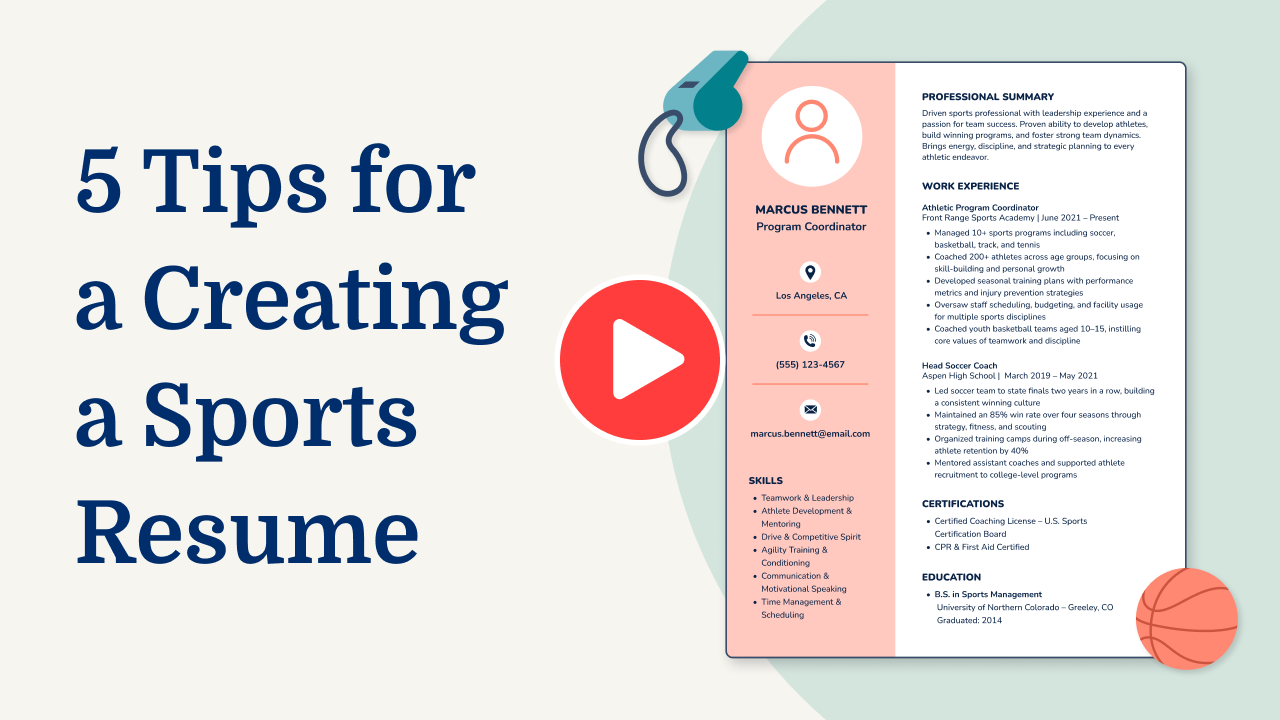
Write a strong professional summary
A professional summary on a resume serves as an introduction, helping hiring managers understand who you are at a glance.
Typically, it consists of three to four sentences showcasing your experience, skills, and accomplishments. This approach is best for those with substantial experience in their field. The purpose of a professional summary is to convey your professional identity and the value you bring to the role.
In contrast, resume objectives state career goals and are ideal for entry-level applicants or those changing careers or with employment gaps. While summaries focus on “what I’ve accomplished,” objectives emphasize “what I aim to contribute.”
Let’s take a look at examples of both summaries and objectives tailored for different industries and levels of experience.
Swim coach resume summary examples
Entry-level
Recent graduate with a Bachelor of Science in kinesiology and certification as a lifeguard. Passionate swim coach with foundational skills in teaching swimming basics, water safety, and stroke development to young swimmers. Adept at creating engaging lesson plans and fostering a safe learning environment.
Mid-career
Dedicated swim coach with over five years of experience coaching competitive youth teams. Skilled in developing personalized training programs, refining techniques for all strokes, and preparing athletes for local and regional competitions. Certified USA Swimming Coach known for motivating swimmers to reach their full potential through effective communication and goal setting.
Experienced
Veteran swim coach with 15+ years of experience leading high school teams and managing aquatic facilities. Expert in advanced stroke mechanics, team leadership, and strategic planning to improve performance outcomes. Proven track record of guiding athletes to state championships and college scholarships while fostering teamwork and sportsmanship.
Swim coach resume objective examples
Entry-level
Energetic and passionate individual seeking an entry-level swim coach position to use a strong background in competitive swimming and coaching fundamentals. Aiming to inspire and develop swimmers’ skills while fostering a positive and supportive team environment.
Career changer
Dedicated professional transitioning into the role of swim coach, bringing extensive experience in sports education and youth mentoring. Committed to applying leadership abilities and a love for swimming to cultivate athletes’ growth and enthusiasm for the sport.
Recent graduate
Recent kinesiology graduate with a focus on aquatic training seeking to start a career as a swim coach. Eager to apply academic knowledge and personal swimming experience to help swimmers achieve their goals through effective coaching techniques and motivational support.
Make your swim coach resume shine! The Resume Builder helps you highlight your coaching skills and achievements, making it easy to catch the eye of potential employers.
Include relevant certifications and training
Listing certifications and training is important for a swim coach because it shows you are qualified to teach swimming safely. It also helps parents and athletes know they can trust your skills and knowledge.
When you have the right certifications, it shows you understand how to handle emergencies, improve techniques, and design effective workouts. Having a dedicated certifications section on your resume makes these qualifications easy to find.
- American Red Cross Water Safety Instructor
- Lifeguard Certification
- CPR/AED for Professional Rescuers
- USA Swimming Coach Certification
- First Aid/CPR/AED Instructor
These certifications help you stand out as a swim coach by showing that you’re prepared and knowledgeable. They ensure you’re equipped to teach swimmers of all levels while keeping safety in mind. Including them prominently on your resume supports your credibility as an expert in the field.
Example of a certifications section
USA Swimming Coach Certification
Issued by: USA Swimming
Expires 2025
Lifeguard Certification
Issued by: American Red Cross
Issued 2023
Water Safety Instructor (WSI)
Issued by: American Red Cross
Expires 2026
CPR and First Aid Certification
Issued by: American Heart Association
Issued 2022
Choose a resume template with clear section headings, professional fonts, and bold colors to ensure your qualifications are front and center.
Showcase your work experience
Your work experience is key when applying for a swim coach job. This part of your resume tells employers what you’ve done in the past and how it makes you a good fit for their team. To make a strong impression, list your jobs starting with the most recent.
For each role, include your job title, the employer’s name, where you worked, and when you were there. Use action words to describe what you did and focus on achievements that can be measured. This helps show how you made a difference in past roles.
While describing your work as a swim coach, highlight important skills like teaching swimming techniques, planning training sessions, and ensuring safety during lessons. Also mention any success stories—like helping swimmers improve their times or win competitions—that show your impact.
By using specific examples and numbers, such as “increased team performance by 20%,” you give employers a clear idea of what you can bring to their program.
Keep descriptions short but informative so it’s easy for someone to see why you’re right for the job. Remember to focus on the skills and experiences most relevant to being a swim coach, and always tailor your resume to match what each employer is looking for in their ideal applicant.
5 swim coach work history bullet points
- Developed tailored swim training programs for over 50 athletes, resulting in a 20% increase in personal bests at regional competitions.
- Coached a high school swim team to achieve a 95% qualification rate for state championships, the highest in the school’s history.
- Implemented advanced video analysis techniques, improving swimmers’ stroke efficiency by an average of 15%.
- Organized and led summer swim clinics attended by more than 100 participants, fostering community engagement and increasing club membership by 30%.
- Mentored junior coaches on effective teaching methodologies, improving team performance and cohesion.
Swim coaches should choose a resume format that highlights coaching experience, swimming skills, and team leadership.
Match your resume with the job description
Tailoring resumes to job descriptions is essential because it helps job seekers stand out to employers and pass through ATS. These systems scan resumes for specific keywords and phrases from job postings, making it important to customize your resume with the language of the job description.
An ATS-friendly resume effectively uses these keywords. By incorporating relevant terms and phrases that match your skills, you can increase your chances of getting noticed by hiring managers. This alignment shows that you are a good fit for positions like swim coach.
To find keywords from a job posting, look for skills, qualifications, and duties mentioned repeatedly. For example, if terms such as “stroke development,” “team leadership,” or “safety protocols” appear often, include them in your resume using exact phrasing.
Incorporate these terms naturally into your resume content by rewriting descriptions. For instance, transform “Provide stroke development training” into “Trained swimmers on stroke development techniques to improve performance.”
Targeted resumes improve ATS compatibility by demonstrating a clear match between your experience and the job requirements. This approach increases the likelihood of progressing to the interview stage.
Make your resume stand out! Try our ATS Resume Checker to catch layout problems, missing keywords, or design flaws that could keep you from getting noticed by hiring managers.
FAQ
Do I need to include a cover letter with my swim coach resume?
Yes, including a cover letter with your swim coach resume can make your application more powerful and boost your chances of landing the role.
A cover letter offers an opportunity to highlight your coaching experience, certifications, and commitment to fostering swimmers’ growth beyond what is listed on your resume.
For example, if the facility emphasizes teamwork or youth development programs, you can illustrate how you’ve successfully implemented similar initiatives in past coaching roles.
You might consider using a Cover Letter Generator to quickly craft a polished cover letter that aligns with the job description or customize one from scratch for the position.
Additionally, browsing through cover letter examples can provide inspiration and ensure yours reflects the professionalism expected in sports and recreation roles like swim coaching.
How long should a swim coach’s resume be?
For a swim coach, a one-page resume is typically ideal for emphasizing core skills like coaching techniques, swimmer development, and team leadership. This length lets you efficiently showcase your most relevant achievements and certifications without overwhelming potential employers.
If you possess extensive experience or specialized qualifications that make you stand out, a two-page resume might be appropriate. Include only what adds real value to your application—such as notable competitions you’ve coached in or unique training programs you’ve developed—to maintain focus and interest.
Explore our insights on how long a resume should be to assess what suits your career stage best.
How do you write a swim coach resume with no experience?
If you need to write a resume with no experience for a swim coach role, focus on highlighting your skills, education, and any related activities that show your potential as a coach. Follow these tips:
- Emphasize relevant certifications: List any lifeguard or swim instructor certifications you’ve obtained. These demonstrate your knowledge of swimming techniques and safety protocols.
- Highlight education: Include details about any courses or degrees related to physical education, sports management, or coaching. Mention specific classes that relate to swimming or athletic training.
- Showcase transferable skills: Skills like leadership, communication, and teamwork are important for coaching. If you’ve gained these through other roles or volunteer work, make sure to highlight them.
- Include volunteer experience: If you’ve volunteered at community pools, summer camps, or school swim teams, describe your responsibilities and how they prepared you for a coaching role.
Using these tips can help you craft a strong swim coach resume with no experience by focusing on what makes you a good fit for the role despite lacking direct coaching experience.
Rate this article
Swim Coach
Additional Resources
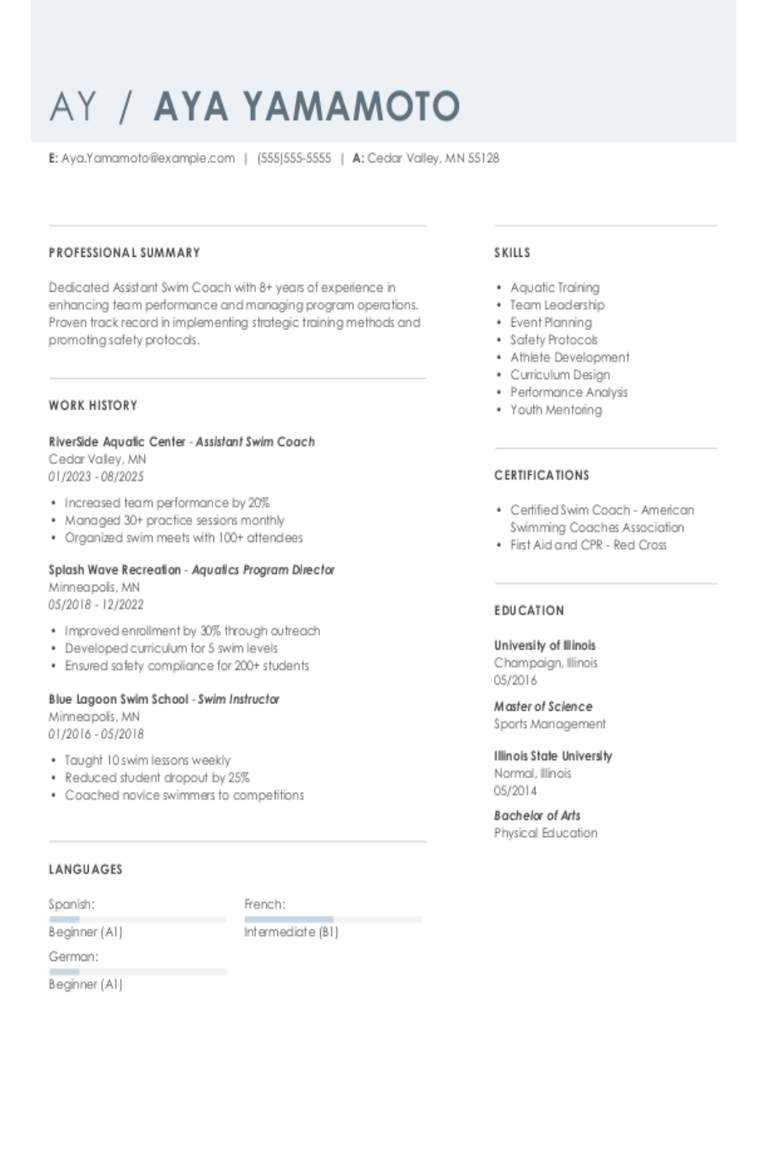
Assistant Swim Coach Resume Examples & Templates for 2025
Discover assistant swim coach resume examples and tips that will help you write about coaching experience, swimmer development, and creating a safe training environment.Build my resumeImport existing resumeCustomize this templateWhy
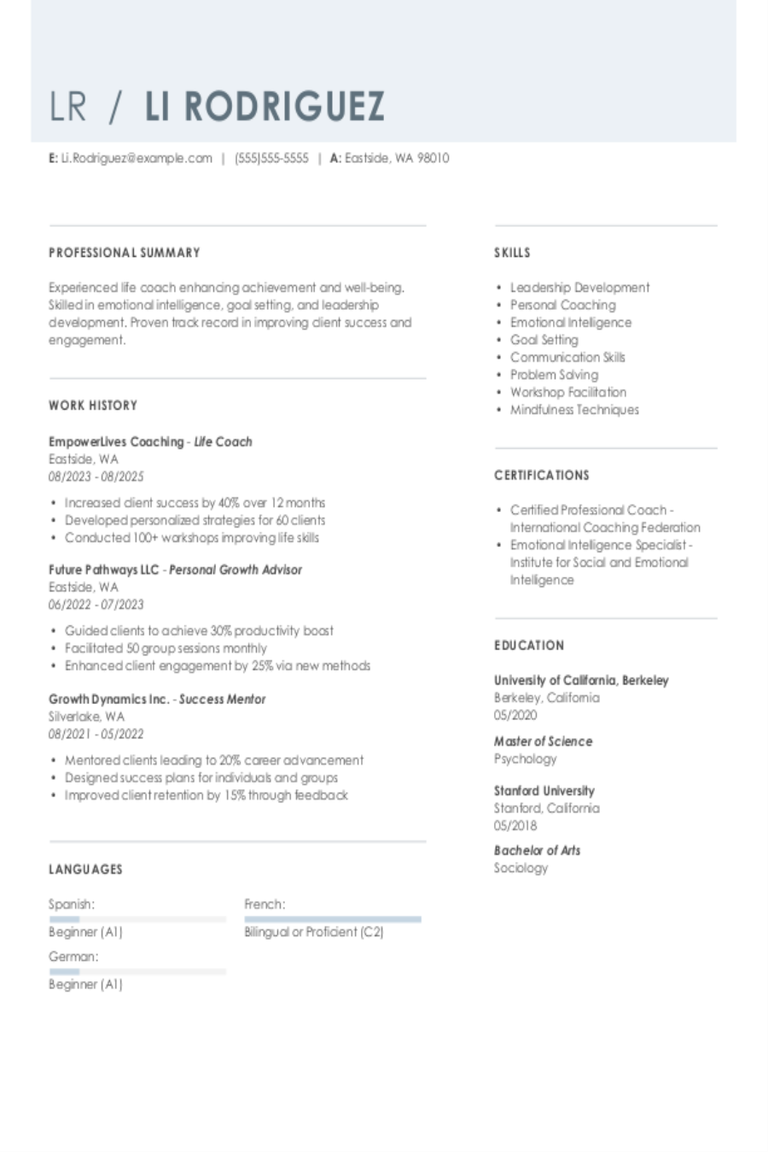
Life Coach Resume Examples & Templates for 2025
Discover life coach resume examples and tips that will help you create a resume that highlights your coaching skills and experience effectively.Build my resumeImport existing resumeCustomize this templateWhy this resume
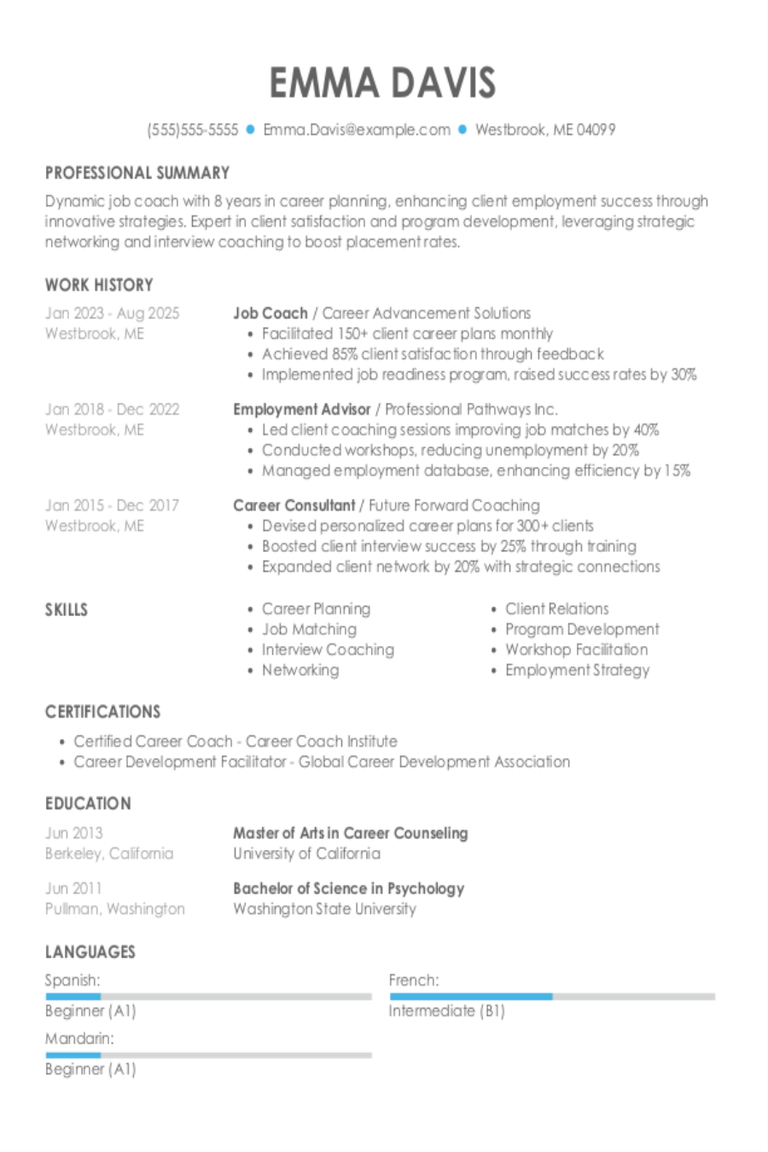
Job Coach Resume Examples & Templates for 2025
Browse job coach resume examples and learn how to highlight your coaching skills, experience with job placements, and success in helping clients achieve their goals.Build my resumeImport existing resumeCustomize this
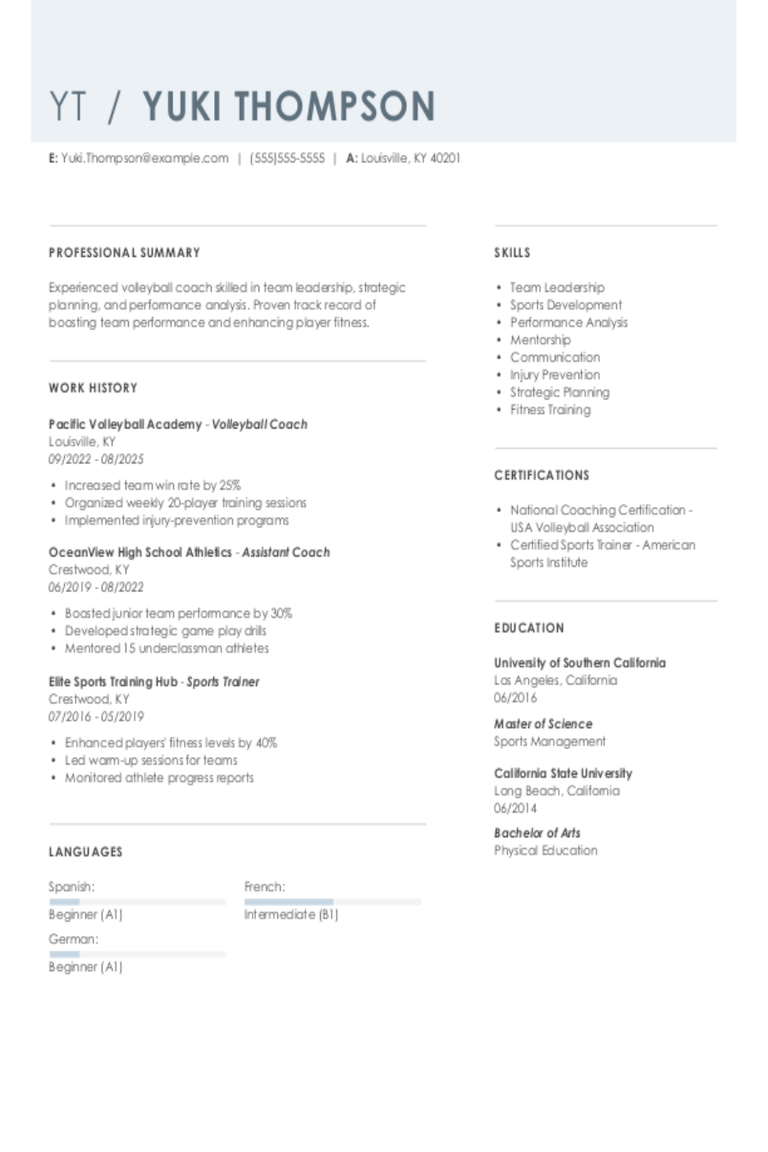
Volleyball Coach Resume Examples & Templates for 2025
Browse volleyball coach resume examples and tips to learn how to highlight your coaching skills, team leadership, and game strategy experience in a way that stands out.Build my resumeImport existing
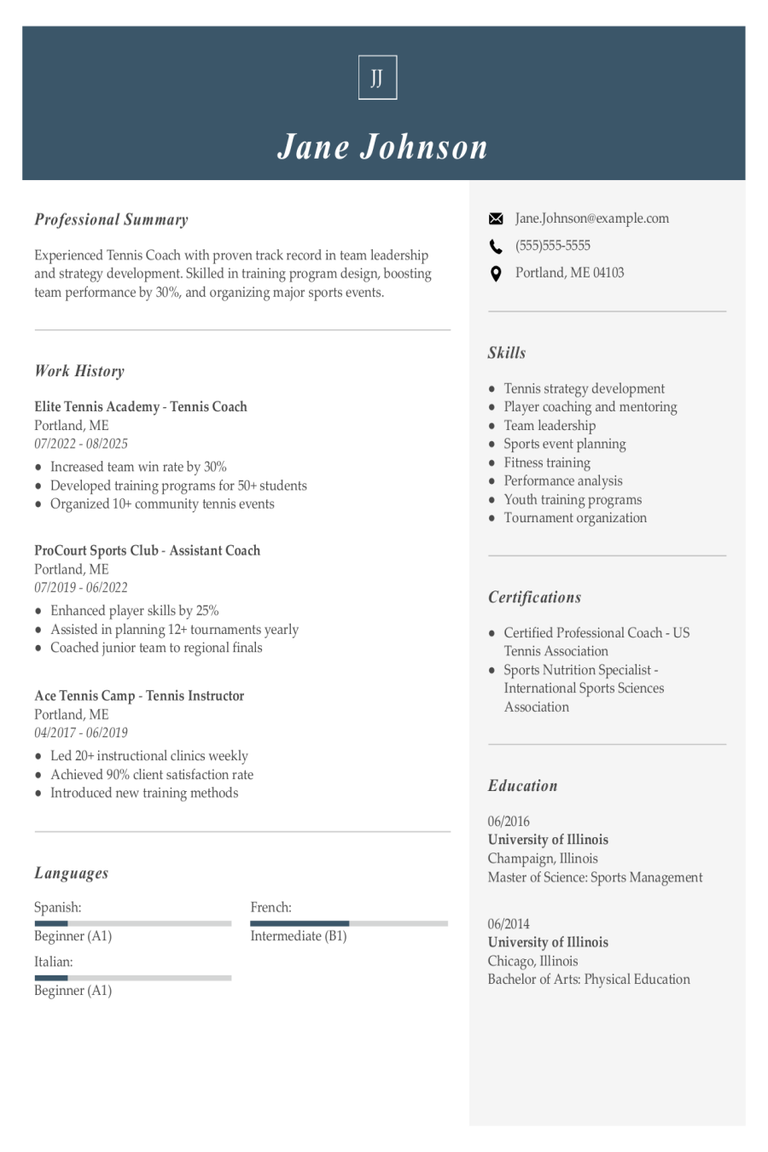
Tennis Coach Resume Examples & Templates for 2025
Discover tennis coach resume examples and learn how to highlight skills like teaching techniques, analyzing player performance, and planning training sessions.Build my resumeImport existing resumeCustomize this templateWhy this resume
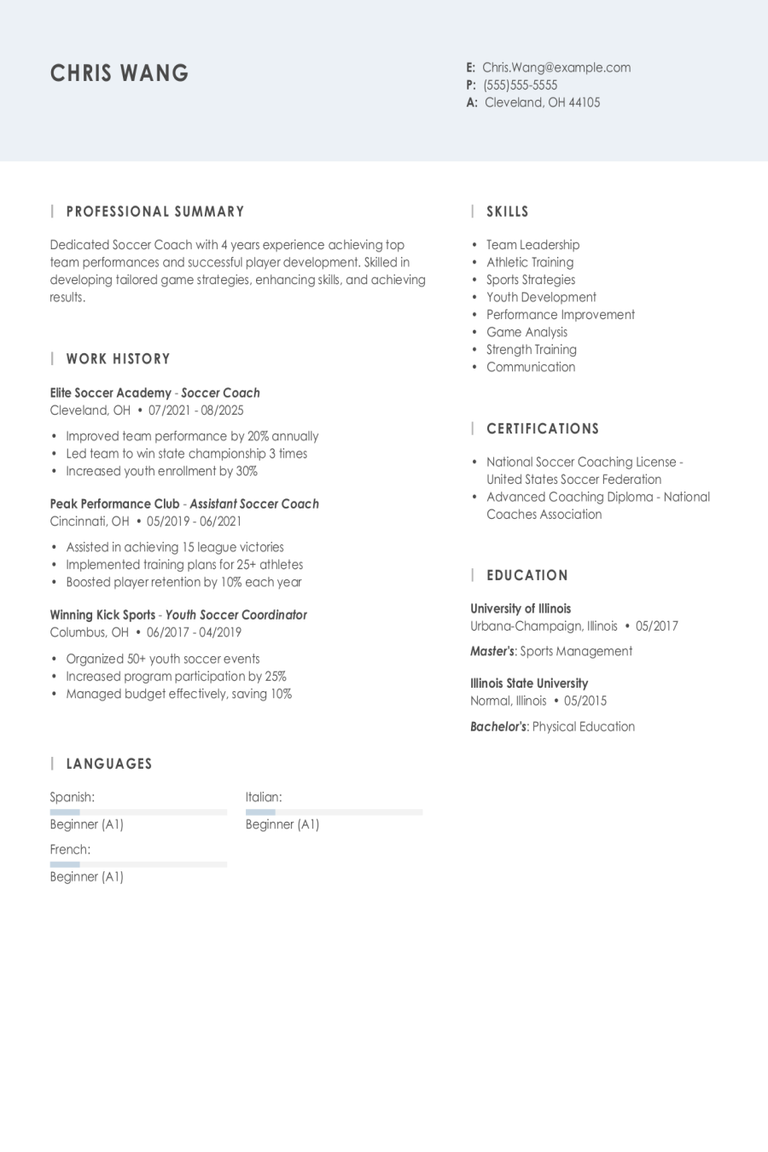
Soccer Coach Resume Examples & Templates for 2025
Explore soccer coach resume examples and learn how to highlight coaching skills and relevant experience in a simple and clear way.Build my resumeImport existing resumeCustomize this templateWhy this resume worksQuantifies
